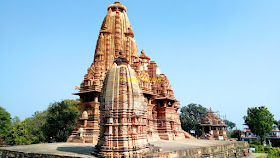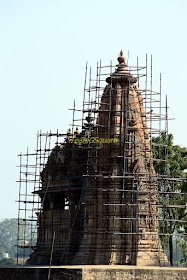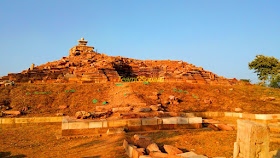We planned to halt at Khajuraho for that night after completing Orchha and started late evening. The drive was very
difficult and tricky due to poor visibility, owing to the fog
accumulation. We had to cross a small
area of Uttar-Pradesh where the highway police were in full action, stopping by
vehicles for checking and inquiry. We were allowed to pass by them. After
driving carefully for more than half the distance towards Khajuraho, we suddenly
realized that my ID was not returned by the lodge staff at Orchha!! Thoroughly
disappointed with our negligence, we were contemplating whether or not to drive
back to Orchha for the ID, as we had already traveled more than a 100 km. While
I insisted it would not be feasible to do the same keeping in mind the bad
foggy night drive and distance, my wife insisted that we drive back and get the
ID as it was an important document and the lodge staff were rude and not
trustworthy. Somehow she convinced me and taking a U-turn, we drove towards
Orchha keeping our cool. We informed the lodge staff to keep the ID ready and
that we were heading back to bring it. We had to pass by the police check again
and this time, we were stopped by them and inquired as to why we had been
traveling to and fro in such a short interval! We had our vehicle checked and
after a thorough explanation of our story and showing them our ID’s, we were
sent. This was the only encounter with Police during our entire MP trip. We
reached Orchha and collected the ID and headed to Khajuraho without wasting any
much time. This entire process added only additional stress and strain, but
also was quite exciting! We reached Khajuraho around 1:00 am only to find that
the roads were deserted and most of the lodges either were not responding or closed.
After knocking on many lodges and and not getting any response, we stopped by Hotel Zostel and found an accommodation for the night.
Khajuraho Monuments, a UNESCO
World Heritage Site is renowned for its exquisite carvings of erotic sculptures
that adorn its temple walls. This region was known as Jejakbhukti in medieval times
and holds a significant role in Indian history. The remarkable temples at
Khajuraho were built between 950 and 1050 AD by the Chandelas. Originally,
there were around 85 temples, out of which now only around 22 survive. Most of
the temples are built of sandstone except the Chausath Yogini, Brahma and
Lalguan Mahadeva which are constructed partly of granite. The temples belong to
Shaiva, Vaishnava and Jaina sects. The temples at Khajuraho are built in Nagara
style of architecture and mark the culmination of Indian architecture design.
The sculptures found on the exterior and interior of the temples at Khajuraho
portray images of gods, goddesses and other divine figures, apsaras and
sura-sundaris (celestial nymphs and beauties), amorous couples (mithuna),
mythical creatures and animals, musicians and dancers, war and hunting scenes, and
scenes from daily life. The temples are divided into western, eastern and southern
groups.
 |
| Reaching New Heights - Khajuraho |
The Western Group
Lakshmi Temple: This small temple is dedicated to Goddess Lakshmi,
consort of Lord Vishnu and is plain, and simple in its structure and style.
 |
| Lakshmi Temple, Khajuraho |
Varaha Temple: This sandstone temple is built on a high platform
and is simple in style. It enshrines a massive murti of Varaha (the boar incarnation
of Lord Vishnu) which carries impressive miniature carvings of Hindu deities,
close to 675 in number all over its body. At the base of the Varaha murti is
seen a serpent and remains of a damaged sculpture, probably one of Goddess Bhudevi
(earth goddess). This temple is datable to 900-925 AD.
 |
| Varaha Temple, Khajuraho |
 |
| Grand Lord Varaha |
Lakshmana Temple: The temple is dedicated to Lord Vishnu and was
built by the Chandela ruler Yashovarman between 930 and 950 AD. The temple stands
on a high platform and consists of an ardha-mandapa (entrance porch), mandapa,
maha-mandapa, antarala (vestibule) and garbhagriha (sanctum) with an ambulatory
pathway. The platform has friezes depicting war scenes involving soldiers,
elephants, camels, horses and other processions. The entrance is decorated with
a beautifully and elegantly carved makara torana (arched entrance flanked by
crocodiles). The sanctum houses a damaged murti of Lord Vishnu depicted as
Vaikuntha with 3 faces (human, lion, and boar) and 4 arms. The exteriors of the temple are decked with
intricately carved balconies with balustrades. The outer walls of the temple
have two bands of sculptures of various gods and goddesses, sura-sundaris
captured in different moods, and amorous couples and erotic scenes.
 |
| Lakshmana Temple, Khajuraho |
Kandariya Mahadev Temple: This marvelously
beautiful temple is dedicated to Lord Shiva and was built between 1025 and 1050
AD. It consists of an entrance porch, mandapa, maha-mandapa, antarala and garbhagriha
with a pradakshina patha (circumambulatory passage). The entrance has an
intricately carved makara torana. Its sanctum houses a shivalinga. The temples symmetrical
proportioning is perfectly executed and so are its design and sculptures that adorn
the walls. The temple stands on a high platform
carved with ornamental mouldings, geometric patterns, and friezes of elephants,
horses, musicians, dancers, hunters, warriors, and miscellaneous scenes. The
central shikara along with the miniature shikaras is imposing and impressive. It
is an outstanding monument of Khajuraho.
 |
| Kandariya Mahadeva Temple, Khajuraho |
Jagadambi Temple: Originally dedicated to Lord Vishnu, this temple
now houses a murti of goddess Parvati in the sanctum. The temple stands on a
high platform and consists of a sanctum, vestibule, a maha-mandapa with lateral
transept and an entrance porch. The lintel of the sanctum contains a carving of
four armed image of Lord Vishnu. Its outer walls are decorated with carvings of
celestial beauties and amorous couples. The temple is datable to 1000-1025 AD.
 |
| Jagadambi Temple, Khajuraho |
Chitragupta Temple: This temple is dedicated to Lord Surya, the sun
god and stands on a high platform. It consists of a sanctum, vestibule, a maha-mandapa
with lateral transept and an entrance porch. The sanctum houses an impressive murti of the sun god driven by 7 horses. The outer walls of the temple carry
carvings of celestial beauties (sura-sundaris), amorous couples and deities, including
a partially damaged image of eleven headed Vishnu in the central niche of the
south facade. The temple is datable to
1000-1025 AD.
 |
| Chitragupta Temple, Khajuraho |
Vishwanatha Temple: This temple was built by the Chandela king
Dhanga in 1002 AD and is dedicated to Lord Shiva. It is among the finest
monuments of Khajuraho, housing beautiful sculptures. Originally being a panchayatana
shrine, now only 2 subsidiary shrines have survived. The temple consists of an
entrance porch, mandapa, mahamandapa and garbhagriha enclosed by an ambulatory.
The inscription on the mandapa also refers to dedications of 2 lingas, one made
of emerald and the other of stone.
 |
| Vishwanatha Temple, Khajuraho |
Nandi Shrine: Standing apart
and facing the main deity Lord Shiva of Vishwanatha temple is a large murti of
Nandi, the bull mount of Lord Shiva. The
Nandi is quite simple and plain in style and enclosed in a small shrine whose
roof is supported by 12 plain pillars.
 |
| Nandi Mantapa |
Matangeshwara Temple: The temple is situated next to the Lakshmana
temple and can be dated to 950-1002 AD. It is dedicated to Lord Shiva in the
form of a linga and is the only temple where daily worship is still continued.
The festival of Mahashivaratri is elaborately celebrated, with many pilgrims
visiting this temple.
 |
| Matangeshwara Temple, Khajuraho |
 |
| Lord Matangeshwara and The Priest |
Chausath Yogini Temple: This granite temple is dedicated to the 64
yoginis and is now in a ruined state with only a few of the cells surviving.
The temple is rectangular in plan with an open courtyard bordered by smaller cells
housing yoginis. It is the earliest surviving temple dating to 900 AD.
 |
| Chausath Yogini Temple, Khajuraho |
The Eastern Group
Brahma Temple: Though it is called as Brahma temple, its sanctum
houses a Shivalinga and the lintel of its sanctum has a carving of Lord Vishnu.
This temple is datable to 900 AD.
 |
| Brahma Temple, Khajuraho |
Vamana Temple: This temple is dedicated to Vamana, the dwarf incarnation
of Lord Vishnu. It consists of a sanctum with seven projections in plan (saptaratha),
vestibule, mandapa with lateral transepts and an entrance porch. The sanctum is
devoid of any ambulatory path (nirandhara) and enshrines an
image of 4 armed vamana flanked by chakrapurusha and shankapurusha on left and right.
The shikara is simple and the outer walls are decorated with 2 bands of sculptures
which include graceful figures of sura-sundaris. The temple can be dated to
1050-1075 AD.
 |
| Vamana Temple, Khajuraho |
Javari Temple: This temple is dedicated to Lord Vishnu and is
datable to 1075-1100 AD. It has a garbhagriha, vestibule, mandapa and portico
but without pradakshina patha. The makara torana is remarkable and so is its
shikara. The outer walls are decorated with 3 bands of beautifully carved sculptures.
 |
| Jevari Temple, Khajuraho |
Ghantai Temple: This Jain temple is now completely in ruins, with
only a portion of its mahamandapa and pillars of the entrance porch
surviving. Its name is attributed to the
presence of chain and bell motifs on its tall pillars.
 |
| Ghantai Temple, Khajuraho |
Parshvanatha Temple: This is the largest and best preserved among
the Jain temples of Khajuraho having individual features of plan and design.
The temple was built in the middle of the 10th century and is
partially made up by latticed windows and has a shrine attached to the rear of
the sanctum. The three bands of sculptures on its outer walls feature graceful sura-sundaris,
celestial beings, couples, Hindu gods and goddesses which are exquisitely
finished.
 |
| Parshvanatha Temple, Khajuraho |
Adinatha Temple: This Jain temple is dedicated to Jina Adinatha and
was built in the latter half of the 11th century. It now consists
only of a sanctum without any ambulatory path and a vestibule. The exterior
walls comprise of three bands of sculptures including graceful sura-sundaris.
 |
| Adinatha Temple, Khajuraho |
The Southern Group
Dulhadeo Temple: The temple faces east and is dedicated to Lord
Shiva. It consists of a sanctum which houses a linga, vestibule, mahamandapa
and an entrance porch. The main shikara is clustered round by 3 rows of
miniature shikaras and looks plain. There are 3 bands of sculptures seen on the
outer walls. The original temple is can be dated to the early 12th century AD
and has undergone extensive repair and restoration at a later stage.
 |
| Dulhadeo Temple, Temple |
Chaturbhuj Temple: The temple stands on a high platform and is
dedicated to Lord Vishnu. It consists of a sanctum without an ambulatory, a
vestibule, mandapa and an entrance porch. The sanctum houses a 9 feet tall murti
of four armed Lord Vishnu. The lower part of the doorway of sanctum shows Ganga
on the right and Yamuna on the left, standing in tribhanga flanked by door
keepers. This temple is devoid of any erotic sculptures. There are three bands
of sculptures around the outer walls. The temple is datable to 1100 AD.
 |
| Chaturbhuj Temple, Khajuraho |
 |
| Beautiful Murti of Chaturbhuj Vishnu |
Bijamandal: This group of mounds in the surrounding areas of
Khajuraho is one of the 18 mounds unraveled during an intensive survey by the
ASI in 1980. Excavations at the main mound of Bijamandal group in 1998-99 exposed
remains of a big temple comparable in size with the Vishwanatha temple at
Khajuraho and a huge Shivalinga, presence of other temples, sculptures and
artifacts. However, the site is yet to
be fully excavated and completely explored.
 |
| Bijamandal, Khajuraho |
How to reach Khajuraho: Khajuraho is well connected by air and also has a good
bus network. However, the options of train travel directly to Khajuraho are
limited, with one having to hire a cab to travel to Khajuraho from the nearest
railway station. By road, we traveled on NH 39 from Orchha until a turn
towards left directing towards Khajuraho.
Entry Fee: Entry
is Rs.30/- for Indians and Rs.500/- for foreigners
Accommodation: There
are many options for accommodation here. We stayed at Zostel which is one of
the best budgeted options for bag packers and budget travelers.
Where to eat: There
are many options including a few road-side eateries.
References:
- ASI Information Boards
- Http://pib.nic.in/feature/fe0899/f1908991.html (website)
- Madhya Pradesh – RBS Visitors Guide India
Related Posts:
Amazing place. Awesome Temples.
ReplyDeleteLoved all photos.
Quite a different view of Khajuraho temple. Thanks for sharing such a detailed post with us all. It's very useful..
ReplyDeleteAmazing.. each one of them are breathtaking.. thanks for this share
ReplyDeleteI am mesmerized...super awesome post.
ReplyDelete